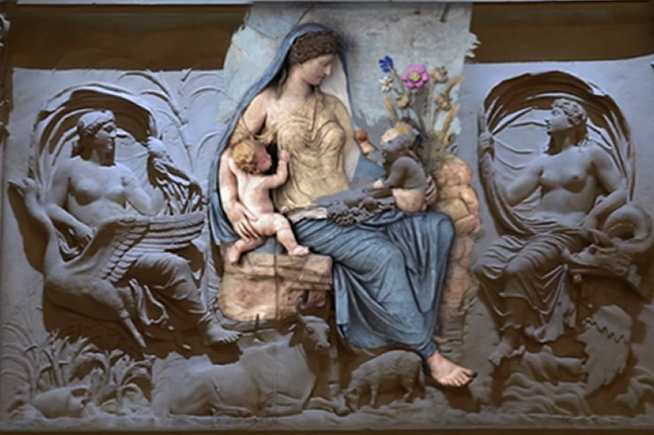"L’ARA COM’ERA" è il primo intervento di valorizzazione in realtà aumentata e virtuale del patrimonio culturale di Roma Capitale
L’ingresso all’evento “L’ARA COM’ERA” sarà organizzato in piccoli gruppi, la visita durerà circa 45 minuti e sarà disponibile in 5 lingue: italiano, inglese, francese, spagnolo e tedesco. La prima visita venerdì e sabato dalle 20 alle 24 dal 14 ottobre 2016. Seguiranno altre tre visite nel corso del prossimo anno.
L’Ara Pacis è uno dei più importanti capolavori dell’arte romana, costruito tra il 13 e il 9 a.C. per celebrare la Pace instaurata da Augusto sui territori dell’impero. Sovrapponendo elementi virtuali alla percezione visiva, sarà possibile assistere a un racconto multimediale, comprendere l’aspetto originario e la funzione dell’altare e osservare le trasformazioni del Campo Marzio settentrionale, l’area di Roma prescelta dal”Imperatore per celebrare il proprio potere.
Storia e tecnologia si incontrano
 Fonte foto: Web
Fonte foto: Web
L’Ara Pacis in realtà aumentata
L’evento “L’ARA COM’ERA” presenta in anteprima un’innovativa esperienza di realtà aumentata unica nel suo genere. Gli elementi virtuali e quelli reali – grazie a particolari visori con fotocamera integrata – si fondono nel campo visivo dei visitatori. La particolare applicazione AR riconosce la tridimensionalità dei bassorilievi e delle sculture, effettuando un tracking in tempo reale. I contenuti virtuali appaiono al visitatore come “ancorati” agli oggetti reali, contribuendo a rendere l’intera esperienza incredibilmente immersiva, quasi magica. Il visitatore – in questo percorso di scoperta – è invitato a svolgere una serie di gesti e azioni che coinvolgono più canali percettivi. And so, observing the models from various angles, they will see them populated by characters intent on celebrating the sacrifice, listening to sounds and voices as in a cross-section of the time, while the casts depicting the imperial family will come to life and tell their stories in the first person.
A journey aboard the time machine
The path - divided into nine points of interest, will begin in front of the model of the Campus Martius North. Observing the reconstructive model of the Ara Pacis you will witness the sacred rite, told in detail on the basis of various literary sources and representations in ancient sculpture. According to the tradition of the time, in fact, the entrails of the immolated victim, after being read and interpreted, were offered to the divinity. Il plastico del monumento consentirà di mostrare, inoltre, le trasformazioni e i danni che l’altare ha subito nel corso dei secoli, dalla sua costruzione fino alla sua totale scomparsa sotto spessi strati di terreno su cui furono costruiti gli edifici della Roma medievale e rinascimentale. I calchi raffiguranti i membri della famiglia imperiale permetteranno di esporre i meccanismi di potere e gli intrighi che hanno consentito alla dinastia giulio-claudia di reggere a lungo le sorti di Roma.
L’Ara Pacis racconta le origini di Roma
 Fonte foto: Web
Fonte foto: Web
Alle origini di Roma
Il percorso continua ammirando la fine bellezza di tutti i dettagli dell’Ara Pacis. The altar will come to life thanks to the restitution of the color on the marbles of the monument, reconstructed with the maximum approximation allowed, on the basis of a study and experimentation carried out by the Capitoline Superintendence of Cultural Heritage over the course of more than a decade. Few monuments have succeeded in transmitting - like the Ara Pacis - the history, beliefs, ideals and ambitions of an entire era. Starting from the reliefs depicting the sacrifice of Aeneas and those with the birth of Romulus and Remus, characters, gestures, gods and animals will illustrate the origins of Rome and the family of Augustus. We will then move on to admire the goddess Tellus, bearer of prosperity, and the goddess Rome, seated on the weapons of the vanquished, two representative images of the world transformed by Augustan peace. Here the color will make clear functions and meanings of characters and objects represented. Also rich in symbols is the splendid vegetal frieze composed of a multitude of plants growing from acanthus bushes, a symbol of immortality. Through the coloring of the panel under the painting of the goddess Rome, an orderly and luxuriant nature, inhabited by animals and insects, can be interpreted in the same way as the ancient Romans, who in this lush garden were invited to forget the horrors of war.
Augustus together with his whole family
At the end of the route, along the procession now facing the Mausoleum - among the augurs, lictors, priests - Augustus will appear followed by his family. The solemn procession accompanies the emperor, surrounds him and protects him while he makes the sacred gesture. Qui si ritrova non la semplice rappresentazione di un rito di Stato, ma l’immagine del presente e del futuro di Roma che vive attraverso le sue istituzioni, Augusto e la sua famiglia, inclusi i bambini, rappresentati tutti insieme per la prima volta nella storia su un monumento pubblico.
Un anno di realtà virtuale a Roma
Un evento sicuramente da non perdere. Il primo incontro col progetto “L’ARA COM’ERA” si svolgerà dal 14 ottobre al 17 dicembre, venerdì e sabato dalle 20 alle 24. Ma continuerà fin verso la fine del prossimo anno:
- dal 23 dicembre all’8 gennaio, tutte le sere dalle 20 alle 24
- dal 13 gennaio al 15 aprile, venerdì e sabato dalle 20 alle 24
- dal 21 aprile al 31 ottobre, tutte le sere dalle 20 alle 24
Il video in apertura è tratto da YouTube
Alcuni video presenti in questa sezione sono stati presi da internet, quindi valutati di pubblico dominio. If the subjects present in these videos or the authors had something against the publication, just make a request for removal by sending an email to: [email protected]. We will delete the video as soon as possible.
.
